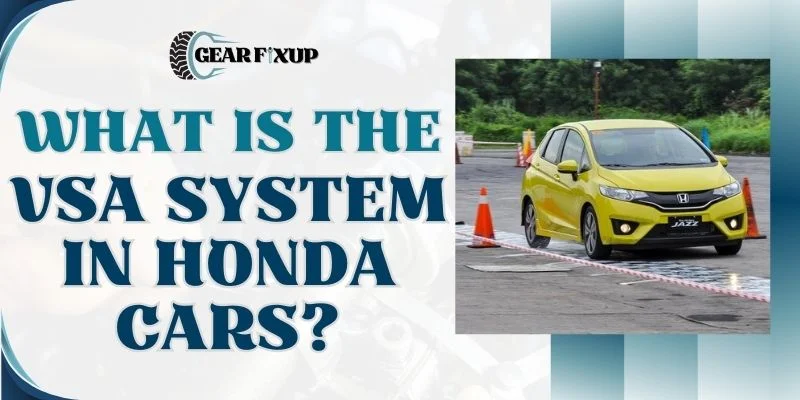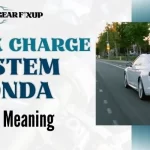Modern auto technology is changing at a rapid pace. In the 21st century, this technology is incredibly advanced, and the Honda VSA is a prime example of this.

The use of electronic stability and traction control systems like VSA is believed to reduce the number of road accidents, especially in poor conditions, and Honda vehicles are equipped with this technology.
What is the VSA System in Honda Cars?
In automobiles, VSA means Vehicle Stability Assist. Understeer or oversteer are detected by the system’s sensors and corrected accordingly during cornering. This is particularly useful when the grip on different wheels is uneven, which can lead to a skid or a plowing.
When driving too fast for the corner, the system may activate due to poor weather conditions, a loose road surface, or a loose road surface. In slippery terrain or steep gradients, VSA can also assist smooth acceleration.

It improves traction by automatically varying engine output and applying brakes to each wheel individually, allowing the driver to keep the car under close control.
VSA light blinks on console
It’s not a fault or warning if your Honda’s VSA light blinks on its console. In simple terms, the flashing light indicates that the system is active and facilitating safer steering. A few changes in handling may be noticed when the system is running, including:
Your engine power may not increase as much as you expected when you use the accelerator.
If you don’t lift the accelerator, the engine may lose power.
There may be an automatic brake application, although this shouldn’t be too noticeable or sudden.
Read more about Honda Odyssey’s 3.5 Firing Order – The Engine’s Rhythmic Heart
Despite being a superb driving aid, the VSA system isn’t perfect. Your Honda may be breaking down because you push it a little too hard.
A permanent activation light for VSAs
This usually means the console switch has been pressed to disable the system rather than light up the VSA activation indicator. You should be able to clear this light by turning the system back on.
You may read Honda Odyssey VSA Light: Causes & Solutions
Indicator light for VSA system
It is important to be aware of the second console light for the VSA. It’s a sign that there’s a problem with the system itself if the VSA System Indicator stays on. You should pull over if you see it, turn off your engine, and then restart it again when it’s safe. You should arrange a service inspection for diagnosis if the light returns.
In the meantime, it’s perfectly safe to drive your car, but the VSA system won’t be there to protect you in difficult conditions, so it’s a good idea to drive with extra care until the problem is fixed.
In what ways does the VSA system work? A Decoding of the Mechanics
The Sensor Fusion Process
Sensor fusion, an integration of data from various sensors, is at the heart of the VSA System. Sensors such as steering input sensors, wheel speed sensors, and lateral acceleration sensors are included in these systems. To maintain stability, the system analyzes real-time data to detect deviations from the driver’s intended path.
Modulation of brakes: A symphony of precision
A wheel braking intervention is initiated when the system detects a possibility of instability. With this precise modulation, the vehicle is kept on its intended trajectory while counteracting oversteer or understeer. This results in a driving experience that feels effortless.
You may also read Honda Pilot Firing Order For Cylinder Numbers From 2002-2015
Beyond Stability: The Advantages of VSA
Improved traction control
As a result of VSA, the vehicle is not only stabilized, but also traction controlled more effectively. No matter how slippery the roads are or how challenging the terrain, the system automatically distributes power to individual wheels, ensuring that every wheel has as much grip as possible.
Read More: Why Is The Honda Civic Brake System Problem Car Won’t Start?
Technology to avoid collisions
The use of VSA adds another layer of safety by incorporating collision avoidance technology. The proactive stability adjustment prevents accidents and protects occupants and drivers by anticipating and mitigating potential collisions.
Check Charge System Honda
Honda Maintenance Code A127 Explained
Frequently Asked Questions
Is VSA Available in All Honda Models?
Yes, of course. Honda makes advanced safety technology accessible to all drivers by including VSA in most models.
Can VSA be Turned Off?
In some Honda models, the VSA can be temporarily disabled, despite being designed to always be on. You can find specific details in the owner’s manual of your vehicle.
Does VSA Replace the Need for Winter Tires?
In spite of the fact that VSA enhances traction control, it does not eliminate the need for winter tires. To ensure optimal safety in snowy conditions, it is still a good idea to use winter tires.
How Often Should VSA be Inspected?
Your vehicle’s manual recommends regular maintenance check-ups in order to keep your VSA system functioning properly. The reliability of a vehicle is enhanced by periodic inspections.
Can Aftermarket Modifications Affect VSA?
VSA performance can be affected by modifications to the vehicle, such as changes in suspension or tires. Before making any significant modifications to your vehicle, consult a qualified mechanic.
Is VSA Different from Electronic Stability Control (ESC)?
Electronic Stability Control is a form of VSA. In Honda’s case, VSA is Honda’s implementation of ESC, which is more broadly defined as ESC.
Conclusion
Finally, Honda Cars’ VSA System ushers in a new era of driving confidence by transcending conventional stability control. Honda’s VSA exemplifies the company’s dedication to safety, ensuring a comfortable and safe journey no matter where your journey takes you.



![Honda A15 Service [What Is Included & Checklist, Cost]](https://gearfixup.com/wp-content/uploads/2024/02/Honda-A15-Service-What-Is-Included-Checklist-Cost-150x150.webp)
